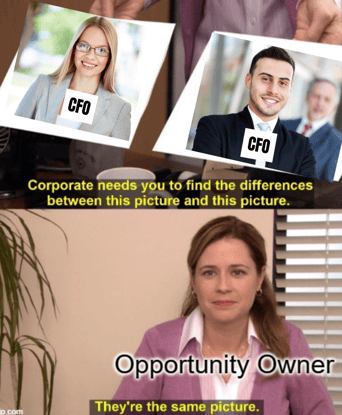“This looks familiar,” I say.
The opportunity owner looks at me quizzically,” I continue.
“Yeah, it’s a similar client. Similar job” they say.
I clear my diary for the afternoon… It’s back to square one.
It’s time to break the shackles of generic labels and figure out what really matters to my client’s client.
What went wrong?

There are many sale-enablement systems out there and a whole bunch of analyses that define the types of people involved in buying processes. These systems have a time and place, but they represent a significant risk to your win strategy.
When can I use them?
Let’s start with where they can add value.
If you are using a sophisticated marketing system that can segment your messaging, grouping people is useful.
Content that executive leadership finds interesting will be different from content that operational and technical people find interesting. But this all occurs outside the context of a specific opportunity.
Within a capture or pursuit effort, using labels as placeholders until you understand the individuals better can be handy. But you must validate them; otherwise, they represent a risk to your strategy.
Why are they so risky?
Basically, because they over-simplify buyers.

If you label stakeholders, the temptation is to apply a standard set of issues based on a typical buyer profile.
“John is the technical buyer, so he is going to be concerned about functionality, maintenance and ease of use”. Before even talking to John, we’ve decided what his issues are. Because this box is now full of information, we tick it off as a completed task.
The reality is - John's much more complicated than that.
These assumptions must be tested. We must engage with John to fully appreciate his biases, risk profile, etc. We can use these assumptions as a placeholder, but we must keep them from forming the foundation of our win strategy.
We see this occur with repeat clients who use Blue Sheets. The similarity between “Economic”, “User”, and “Technical” buyers from opportunity to opportunity suggests that “Key Win” details are assumed based on their role, not acquired from the individual through interaction.
Similarly, if your customer stakeholder profile includes a series of buying roles to populate, you assume that every buying organisation has a similar structure. This is simply not true.
Regardless of how you apply buyer types, the end result is usually the same – a generic win strategy.
Think about it – if you start with the same foundational components, you end up with the same strategic outputs. All you’ve done is put different people’s names in boxes.
So, what should we do?
Firstly, we need to know EVERYONE who is involved in the purchase. Don’t distract yourself with labels or even their title. You must know who they are.
Once you know who the people are, this is what we want to know about them:
1. How much power do they have over the decision (on a scale of 1-5 or 1-10)
2. What are their specific issues relating to this purchase (what problems do they need to be resolved and what do they aspire to)
3. How important is each of those issues to them (on a scale of 1-5 or 1-10)
That’s it!
Once you know these things, you can build a profile of the organisational Hot Buttons. These are the consensus view, across all stakeholders, of what is important.
To do that, you need to know your customers.
Contact and Meeting planners provide discipline around client interactions. A small amount of effort just before, and after a call or meeting with a client significantly improves understanding of their individual issues.
Then what?
Once you have this information, you can start implementing the capture and proposal strategy. By comparing you and your solution against the alternate providers, you can gauge your strengths, weaknesses, opportunities, and threats.
When you understand this, you can implement tactics that improve the client’s opinion of you against the issues that are most important to them.
You're developing the wrong tactics if you don’t get the issues right because you relied on generic stereotypes.
So many business-winning professionals are extremely busy losing. Running around doing many things, most of which don't improve the customer’s perception of you.
Before you do anything, you must know the people who will make the decision.
Not the position on their LinkedIn.
Not the title on their business card.
And not some other generic label.
But instead, know who they are and what they care about.

.png?width=600&height=93&name=Asset%2020%20(1).png)


